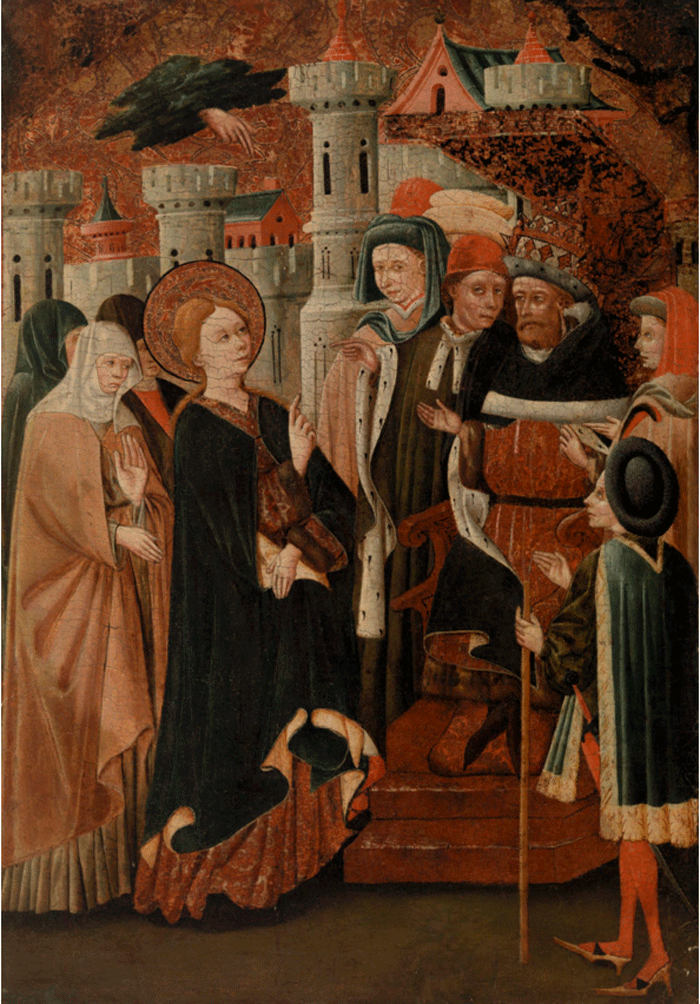Blasco de Grañén, Saint Catherine of Siena before Pope Gregory XI,
A Guided Tour of Philadelphia in the Year 1430
by DoN Brewer
Part three of A Guided Tour of Philadelphia in the Year 1430 stops at The Barnes Foundation at 20th and the Parkway, Blasco de Grañén, Saint Catherine of Siena before Pope Gregory XI, 1422–1459. Tempera with gold leaf on panel, Overall: 34 x 23 1/2 inches.
Blasco de Grañén, known as Master of Lanaja, a Gothic painter in Aragon, an autonomous community of Spain, bordering the North of France, became the named painter of King Juan II of Aragon. “Juan II of Aragon, the Great or Juan without Faith ( Medina del Campo , Castilla , June 29, 1398 – Barcelona , January 20 , 1479 ) was Duke of Peñafiel , King of Navarre ( 1425 – 1479 ), King of Sicily ( 1458 – 1468 ) and King of Aragon , of Mallorca , of Valencia , of Sardinia ( 1458 – 1479 ), son of Fernando I of Antequera and of Leonor de Alburquerque , countess of Alburquerque. Juan II was one of the longest-living monarchs of the fifteenth century.” – Wikipedia
That is royalty! And what do royals want? The best of everything. Blasco de Grañén does his best to please the king by using available technology, gold and tempera paint, to depict qualities of life that appeal the the wealthy and powerful through art. Being able to communicate through plastic means is essential, the use of line, light, color and shape to portray consistency of the surface, the tactile qualities, the weightiness and gravity of environmental space.
The vertical painting contains many of the same subject facts we observed in the Robert Campin and Jan van Eyck paintings: religious piety, elaborate lifestyle, superior textiles and fashion, powerful architectural forms, and portraits. Painted on gold with tempera paint, pigments mixed with fast drying egg yolk, the overall palette is earthy, warm and somber, burnt sienna, umber, greenish umber, and ochre, the surface is smooth with striations of color compartmentalized into complex interconnecting shapes. The Spanish tradition of a heaviness to the color, a flat dryness, and with, like the Flemish, an elaborate attention to detail in textile. The frontal facing figures are stiff but the fabric flows, the variety of textiles from velvet to brocade is prolific.
Compare the figure of Saint Catherine, painted in the Spanish tradition, to the image of the Virgin by Robert Campin, a Netherlandish painter, in the painting Christ and the Virgin. Textile is the major mass of the figure, the pose is static and a primitiveness to the figure, the Byzantine quality to the depiction of folds is inactive, with tricky details over-patterning the surface. The lower third of the figure is dedicated to lovely, flowing, draped flash folds (the tempera is scraped off in striated lines to reveal the gold highlights) and swishy flows, layers of fabric are depicted in dazzling detail. The same soft patterning is repeated in the halo surrounding the portrait, with it’s “hieratic” features, with the glints of gold shining through the flatness of the paint. In the Robert Campin painting the fabric is much more luminous and nuanced, more softness, drape and structure of the fabric is apparent.
Flatness extends to the perspective of the composition, there is no circumambient space, the attempt at movement in the depiction of textiles fails compared to the Flemish, even though the flesh is painted in delicate shades of pink there is no sense of naturalness. The composition is distorted, the landscape flat and stacked, with no clear vanishing point and the intersecting shapes are off balance. The use of paint to render textiles, folds, and texture is extremely important in the picture just as it is the paintings by Robert Campin and Jan van Eyck; the traditions of depicting fabric in clothing changes drastically from flat and arid tempera paint in the Spanish to the naturalistic, ambient and atmospheric quality that oil paint creates.
This ends our art tour of the year 1430 on the Parkway in Philly, I hope you enjoyed the conceit and were able to imagine the techtonic shift in art making from the Late Middle Ages into the Renaissance by the wide acceptance of the use of oil painting that spread throughout the art guilds of Europe. The tradition that became the academies and universities, art schools, studios, and economics of art begins at this time; analyzing paintings from the same time period reveals the power of visual communication through plastic means. I don’t think it’s an exaggeration to compare the change in communication through the arts in an enhanced, technological shift in materiality and the ability to describe ambience and reality as it is to accessing data through media today.
To explore more of the 15th Century watch for my post Party Like It’s 1430, coming soon on DoNArTNeWs.
Link to A Guided Tour of Philadelphia in the Year 1430
Link to Robert Campin, Christ and the Virgin
Link to Jan van Eyck art tobur blog post – click here.
Link to Party Like it’s 1430 blog post – click here
Written by DoN Brewer.
Like DoNArTNeWs Philadelphia Art News Blog on facebook
Follow DoN on Twitter @DoNNieBeat58
@donniebeat on Instagram
More DoNArTNeWs at www.brewermultimedia.com
Affiliate Marketing Disclosure Statement
Donate via safe and secure PayPal in the sidebar.




{ 0 comments… add one now }
You must log in to post a comment.
{ 4 trackbacks }